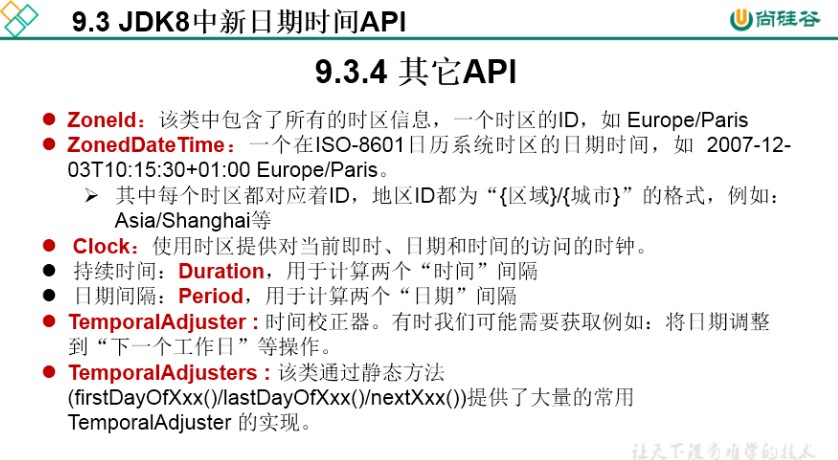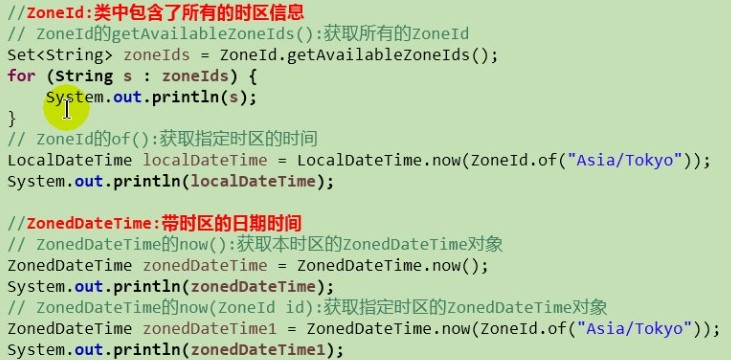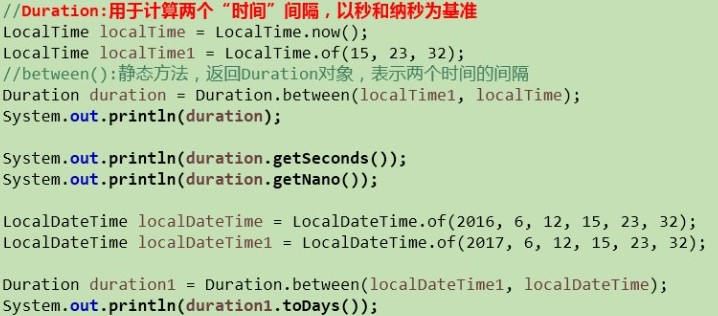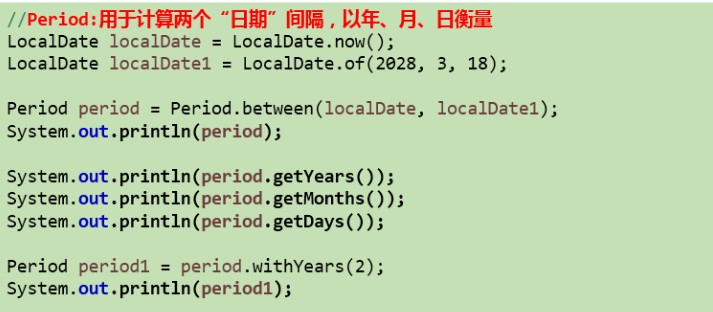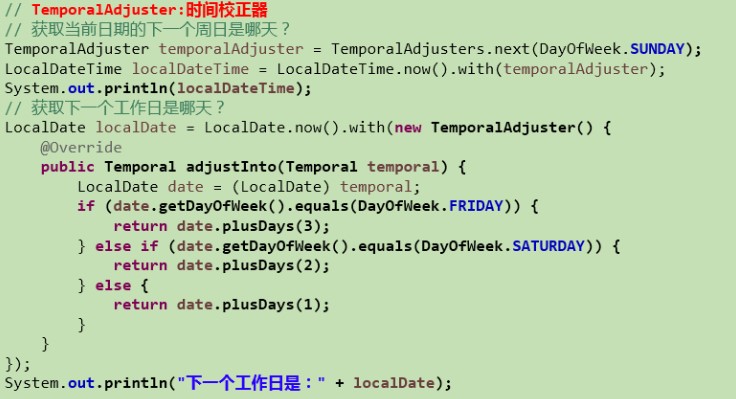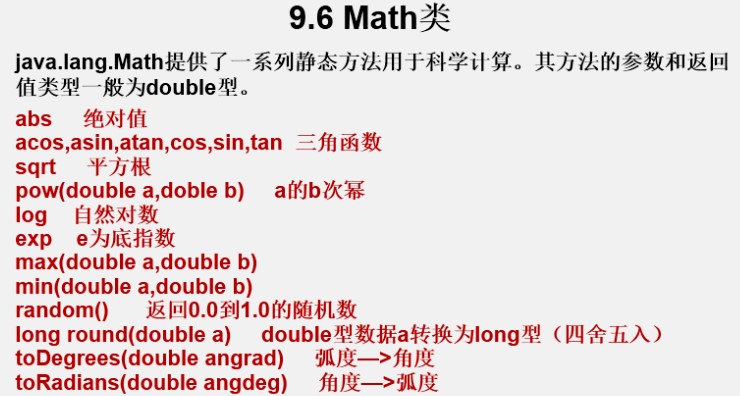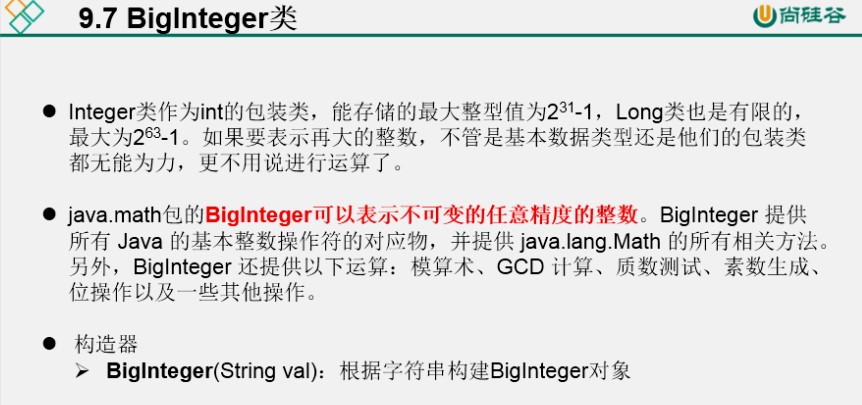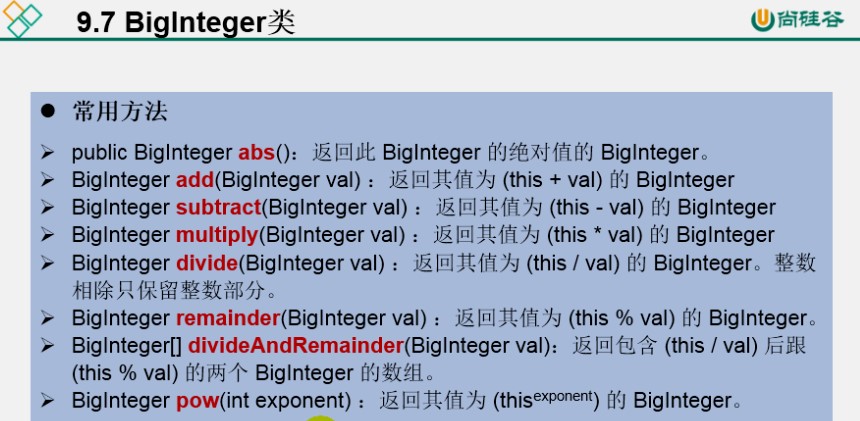String类
字符串,使用一对“”引起来表示
1.String声明为final的,不可被继承
2.String实现了Serializable接口:表示字符串是支持序列化的
实现了Comparable接口:表示String可以比较大小
3.String内部定义了final char[] value用于存储字符串数据
4.String:代表内部不可变的字符序列。简称:不可变 性
体现:1.当对字符串重新赋值时,需要重新指定内存区域赋值,不能使用原有的value进行赋值
2.当对现有的字符串进行连接操作时,也需要重新指定内存区域赋值,不能使用原有的value进行赋值
3.当调用String的replace()方法修改指定字符或字符串时,也需要重新指定内存区域赋值,不能使用原有的value进行赋值
5.通过字面量的方式(区别于new)给一个字符串赋值,此时的字符串值声明在字符串常量池中
6.字符串常量池中是不会存储相同内容的字符串的
public class StringTest {public void test1(){String s1 = "abc";//字面量String s2 = "abc";s1 = "hello";System.out.println(s1 == s2);//比较s1与s2的地址值System.out.println(s1);//helloSystem.out.println(s2);//abcSystem.out.println("****************************0");String s3 = "abc";s3 += "def";System.out.println(s3);//abcdefSystem.out.println(s2);System.out.println("****************************");String s4 = "abc";String s5 = s4.replace('a','m');System.out.println(s4);//abcSystem.out.println(s5);//mbc}}
String实例化的方式
方式一:通过字面量定义的方式
方式二:通过new + 构造器的方式
面试题:String s = new String(“abc”);方式创建对象,在内存中创建了几个对象?
两个,一个是堆空间中new结构,另一个是char[]对应的常量池中的数据:“abc”
public class StringTest1 {public void test2(){//通过字面量定义的方式:此时的s1和s2的数据javaEE声明在方法区中的字符串常量池中String s1 = "javaEE";String s2 = "javaEE";//通过new + 构造器的方式:此时的s3和s4保存的地址值,是数据在堆空间中开辟空间以后对应的地址值String s3 = new String("javaEE");String s4 = new String("javaEE");System.out.println(s1 == s2);//trueSystem.out.println(s1 == s3);//falseSystem.out.println(s1 == s4);//falseSystem.out.println(s3 == s4);//false}}
String拼接操作的对比
1.常量于常量的拼接结果在常量池。并且常量池中不会存在相同内容的常量
2.只要其中有一个是变量,结果就在堆中
3.如果拼接的结果调用intern()方法,返回值就在常量池中
public void test3(){String s1 = "javaEE";String s2 = "hadoop";String s3 = "javaEEhadoop";String s4 = "javaEE" + "hadoop";String s5 = s1 + "hadoop";String s6 = "javaEE" + s2;String s7 = s1 + s2;System.out.println(s3 == s4);//trueSystem.out.println(s3 == s5);//falseSystem.out.println(s3 == s6);//falseSystem.out.println(s3 == s7);//falseSystem.out.println(s5 == s6);//falseSystem.out.println(s5 == s7);//falseSystem.out.println(s6 == s7);//falseString s8 = s6.intern();//返回值得到的s8是使用的常量值中已经存在的“javaEEhadoop”System.out.println(s3 == s8);//true}
String常用类
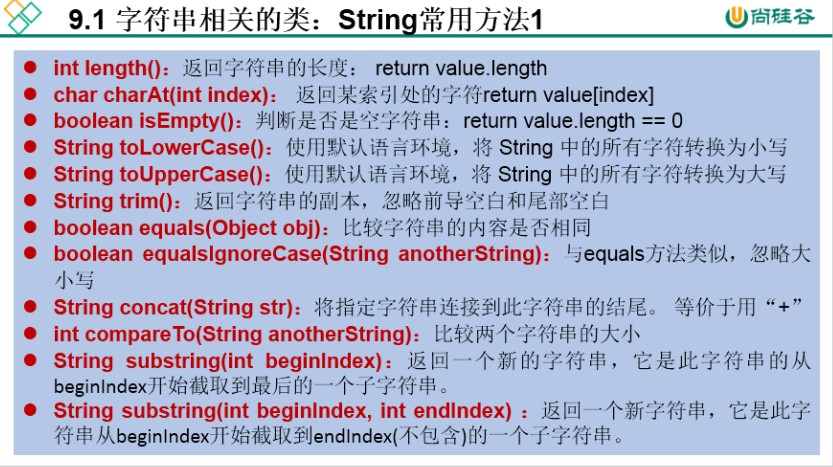
public class StringMethodTest {public void test1(){String s1 = "HelloWorld";System.out.println(s1.length());System.out.println(s1.charAt(0));//HSystem.out.println(s1.isEmpty());String s2 = s1.toLowerCase();System.out.println(s1);//HelloWorld//s1不可变的,仍然为原来的字符串System.out.println(s2);//helloworld//改成小写以后的字符串String s3 = " he ll o wor ld ";String s4 = s3.trim();System.out.println("------" + s3 + "-------");System.out.println("------" + s4 + "-------");}public void test2(){String s1 = "HelloWorld";String s2 = "helloworld";System.out.println(s1.equals(s2));System.out.println(s1.equalsIgnoreCase(s2));String s3 = "abc";String s4 = s3.concat("abd");System.out.println(s4);//abcdefString s5 = "abc";String s6 = new String("abc");System.out.println(s5.compareTo(s6));//涉及到字符串排序String s7 = "abcde";String s8 = s7.substring(2);System.out.println(s7);System.out.println(s8);String s9 = s7.substring(2, 4);System.out.println(s9);}}

public void test3(){String str1 = "helloworld";boolean b1 = str1.endsWith("id");System.out.println(b1);boolean b2 = str1.startsWith("He");System.out.println(b2);boolean b3 = str1.startsWith("ll",2);System.out.println(b3);String str2 = "wor";System.out.println(str1.contains(str2));System.out.println(str1.indexOf("lo"));System.out.println(str1.indexOf("lo",5));String str3 = "helloworld";System.out.println(str1.lastIndexOf("or"));System.out.println(str3.lastIndexOf("or",6));}
什么情况下,indexof(str)和lastIndexof(str)返回值相同?
①存在唯一的一个str
②不存在str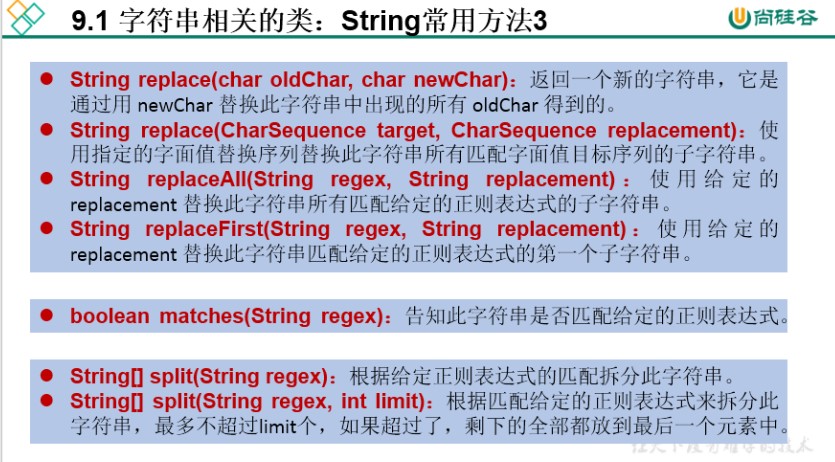
public void test4(){String str1 = "abc";String str2 = str1.replace("a","e");System.out.println(str1);//abcSystem.out.println(str2);//ebcString str = "12hello34world5java7891my456";String string = str.replaceAll("\\d+","," );System.out.println(string);str = "12345";boolean matches = str.matches("\\d+");System.out.println(matches);String tel = "0571-4534289";boolean result = tel.matches("0571-\\d{7,8}");System.out.println(result);str = "hello|world|java";String[] strs = str.split("\\|");for(int i = 0;i<strs.length;i++){System.out.println(strs[i]);}}
String与char[]之间的转换
String —> char[]:调用String的toCharArray()
char[] — >String :调用String的构造器
public void test(){String str1 = "abc123";char[] charArray = str1.toCharArry();for(int i = 0;i < charArray.length;i++){System.out.println(charArray[i]);}char[] arr = new char[]{'h','e','l','l','o',};String str2 = new String(arr);System.out.println(str2);}
String与byte[]之间的转换
编码:String —>byte[]:调用String的getBytes()
解码:byte[] —->String:
编码:字符串 —>字节(看得懂 —->看不懂的二进制数据)
解码:编码的逆过程;字节 —->字符串(看不懂的二进制数据 —->看得懂)
public void test9() throws UnsupportedEncodingException {String str1 = "abc123中国";byte[] bytes = str1.getBytes();System.out.println(Arrays.toString(bytes));byte[] gbks = str1.getBytes("gbk");//使用gbk字符进行编码System.out.println(Arrays.toString(gbks));String str2 = new String(bytes);//使用默认的字符集,进行编码System.out.println(str2);String str3 = new String(gbks);System.out.println(str3);//出现乱码,原因:编码集和解码集不一致String str4 = new String(gbks,"gbk");System.out.println(str4);//没有出现乱码,原因:编码集与解码集一致}
StringBuffer中常用方法
增:qppend(xxx)
删:delete(int start,int end)
改:setCharAt(int n,char ch)/replace(int start,int end,String str)
查:charAt(int n)
插:insert(int offset,xxx)
长度:length()
遍历:for() + charAt()/toString()
String,StringBuffer,StringBuilder三者的异同
String:不可变的字符类型,底层使用char[]存储
StringBuffer:可变的字符序列:线程安全,效率低,底层使用char[]存储
StringBuilder:可变的字符序列,jdk5.0新增,线程不安全,效率高,底层使用char[]存储
三者的效率
从高到低:StringBulider > StringBuffer > String
实现时间戳
System类中的currentTimeMillis()
public void test1(){long time = System.cuurrentTimeMillis();//返回当前时间与1970年1月1日0时0分0秒之间以毫秒为单位的时间差//称为时间戳System.out.println(time);}
java.util.Date类——java.sql.Date类
1.两个构造器的使用
>构造器一:Date():创建一个对应当前时间的Date对象
>构造器二:创建指定毫秒数的Date对象
2.两个方法的使用
>toString():显示当前的年、月、日、时、分、秒
>getTime():获取当前Date对象对应的毫秒数(时间戳)
3.java.sql.Date对应着数据库中的日期类型的变量
>如何实例化
>如何将java.util.Date对象转换为java.sql.Date对象
public void test8(){//构造器一:Date():创建一个对应当前时间的Date对象Date date1 = new Date();System.out.println(date1.toString());//Sat Feb 16 16:35:31 GMT+08:00 2019System.out.println(date1.getTime());//1550306204104//构造器二:创建指定毫秒数的Date对象Date date2 = new Date(516468453484l);System.out.println(date2.toString());//创建java.sql.Date对象java.sql.Date date3 = new java.sql.Date(2564834354l);System.out.println(date3);//1971-02-13//如何将java.util.Date对象转换为java.sql.Date对象//情况一:Date date4 = new java.sql.Date(6168135166496l);java.sql.Date date5 = (java.sql.Date) date4;//情况二:Date date6 = new Date();java.sql.Date date7 = new java.sql.Date(date6.getTime());}
SimpleDateFormat的使用
public void testSimpleDateFormat(){//实例化SimpleDateFormatSimpleDateFormat sdf = new SimpleDateFormat();//格式化:日期-->字符串Date date = new Date();System.out.println(date);String format = sdf.format();System.out.println(format);//解析:格式化的逆过程,字符串--->日期String str = "22-03-25 下午21:26";Date date1 = sdf.parse(str);System.out.println(date1);//按照指定方式格式化和解析:调用带参的构造器SimpleDateFormat sdf1 = new SimpleDateFormat("yyyy-MM-dd hh:mm:ss");//格式化String format1 = sdf1.format(date);System.out.println(format1);//2019-02-18 11:48:27//解析:要求字符串必须是符合SimpleDateFormat识别的格式(通过构造器参数体现)//否则,抛异常Date date2 = sdf1.parse("2020-02-18 11:48:27");System.out.println(date2);}
Calender日历类的使用(抽象类)
public void testCalender(){//1.实例化//方式一:创建其子类(GregorianCalender)的对象//方式二:调用其静态方法getInstance()Calendar calender = Calendar.getInstance();//2.常用方法//get()int days = calender.get(Calendar.DAY_OF_MONTH);System.out.println(days);System.out.println(calender.get(Calendar.DAY_OF_YEAR));//set()calender.set(Calendar.DAY_OF_MONTH,25);days = calender.get(Calendar.DAY_OF_MONTH);System.out.println(days);//add()calender.add(Calendar.DAY_OF_MONTH,3);//加calender.add(Calendar.DAY_OF_MONTH,-3);//减days = calender.get(Calendar.DAY_OF_MONTH);System.out.println(days);//getTime() 日历类--->DateDate date = calender.getTime();System.out.println(date);//setTime() Date--->日历类Date date1 = new Date();calender.setTime(date1);days = calender.get(Calendar.DAY_OF_MONTH);System.out.println(days);}
LocalDate,LocalTime,LocalDateTime的使用
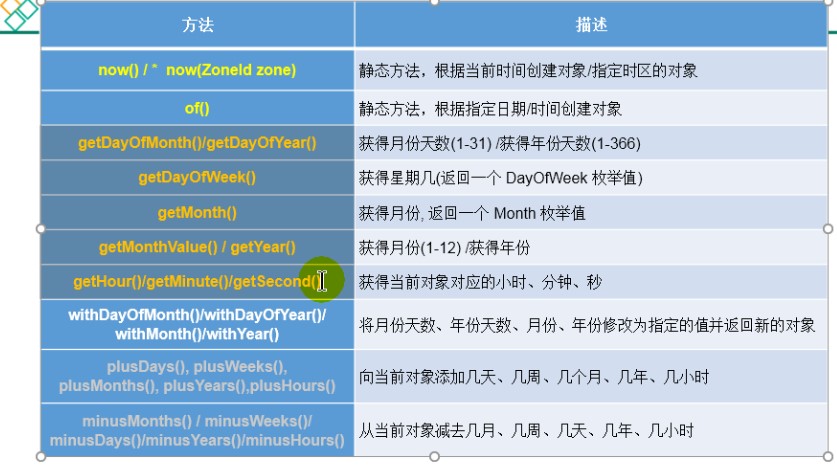
public void test1(){//now():获取当前日期、时间、日期+时间LocalDate localDate = LocalDate.now();LocalTime localTime = LocalTime.now();LocalDateTime localDateTime = LocalDateTime.now();System.out.println(localDate);System.out.println(localTime);System.out.println(localDateTime);//of():设置指定的年、月、日、时、分、秒,没有偏移量LocalDateTime date = LocalDateTime.of(2020, 3, 26, 11, 29, 56);System.out.println(date);//getXxx():获取相关属性System.out.println(localDateTime.getDayOfMonth());System.out.println(localDateTime.getDayOfWeek());System.out.println(localDateTime.getMonth());System.out.println(localDateTime.getMonthValue());System.out.println(localDateTime.getMinute());//体现不可变性//withXxx():设置相关的属性LocalDate localDate1 = localDate.withDayOfMonth(22);System.out.println(localDate1);System.out.println(localDate);LocalDateTime localDateTime2 = localDateTime.withHour(4);System.out.println(localDateTime);System.out.println(localDateTime2);//不可变性//对于当前时间增加指定数量的年、月、日、时、分、秒LocalDateTime localDateTime3 = localDateTime.plusMonths(3);System.out.println(localDateTime);System.out.println(localDateTime3);//对于当前时间减少指定数量的年、月、日、时、分、秒LocalDateTime localDateTime4 = localDateTime.minusHours(3);System.out.println(localDateTime);System.out.println(localDateTime4);}
Instant的使用
instant:瞬时
类似于 java.util.Date类
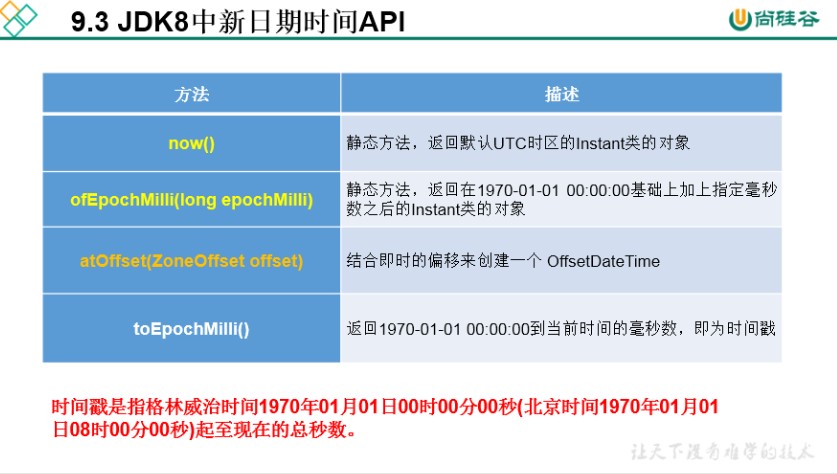
public void test2(){//now():获取本初子午线对应的标准时间Instant instant = Instant.now();System.out.println(instant);//2022-03-26T03:57:20.225Z//添加时间的偏移量OffsetDateTime offsetDateTime = Instant.now().atOffset(ZoneOffset.ofHours(8));System.out.println(offsetDateTime);//2022-03-26T11:57:20.275+08:00//获取自1970年1月1日0时0分0秒(UTC)开始的毫秒数 ---> Date类中的getTime()long milli = instant.toEpochMilli();System.out.println(milli);//ofEpochMilli():通过给定的毫秒数,获取Instant实例 ---> Date(long millis)Instant instant1 = Instant.ofEpochMilli(56164623168465L);System.out.println(instant1);}
DateTimeFormatter的使用

public void test3(){//方式一:预定义的标准格式。如:ISO_LOCAL_DATE_TIME,ISO_LOCAL_DATE,ISO_LOCAL_TIMEDateTimeFormatter formatter = DateTimeFormatter.ISO_DATE_TIME;//格式化:日期-->字符串LocalDateTime localDateTime = LocalDateTime.now();String str1 = formatter.format(localDateTime);System.out.println(localDateTime);System.out.println(str1);//2022-03-26T14:51:52.448//解析:字符串-->日期TemporalAccessor parse = formatter.parse("2022-03-26T14:51:52.448");System.out.println(parse);//{},ISO resolved to 2022-03-26T14:51:52.448//方式二:本地化相关格式。如:ofLocalizeDateTime()//FormatStyle.SHORT FormatStyle.MEDIUM FormatStyle.LONG FormatStyle.FULLDateTimeFormatter dateTimeFormatter = DateTimeFormatter.ofLocalizedDateTime(FormatStyle.SHORT);//格式化String str2 = dateTimeFormatter.format(localDateTime);System.out.println(str2);//22-3-26 下午3:00// 重点 方式三:自定义的格式 如:ofPattern("yyyy-MM-dd hh:mm:ss E")DateTimeFormatter formatter3 = DateTimeFormatter.ofPattern("yyyy-MM-dd hh:mm:ss E");String str4 = formatter3.format(localDateTime.now());System.out.println(str4);//2022-03-26 03:11:42 星期六//解析TemporalAccessor parse1 = formatter3.parse("2022-03-26 03:11:42");System.out.println(parse1);}
其他日期时间相关的API的使用
Java比较器
说明
Java中的对象,正常情况下,只能进行比较:==或!=,不能使用 > 或 < ,但是在开发场景中,我们需要对多个对象进行排序,言外之意,就需要比较对象的大小
使用两个接口中的任何一个:Comparable或Comparator
Compara接口的使用
自然排序
1.像String、包装类等实现了Comparable接口,重写了compareTo(obj)方法,给出了比较两个对象的方法
2.像String、包装类重写compareTo()方法以后,进行了从小到大的排列
3.重写compareTo(obj)的规则
如果当前对象this大于形参对象obj,则返回正整数
如果当前对象this小于形参对象obj,则返回负整数
如果当前对象等于形参对象obj,则返回零
4.对于自定义类来说,如果需要排序,我们可以让自定义类实现Comparable接口,重写compareTo(obj)方法,在compareTo(obj)方法中指明如何排序
//测试类public void test2(){Goods[] arr = new Goods[5];arr[0] = new Goods("lenovoMouse",99);arr[1] = new Goods("dellMouse",119);arr[2] = new Goods("xiaomiMouse",89);arr[3] = new Goods("huaweiMouse",199);arr[4] = new Goods("microsoftMouse",119);Arrays.sort(arr);System.out.println(Arrays.toString(arr));}
//创建对象public class Goods implements Comparable{private String name;private double price;public Goods(){}public Goods(String name, double price) {this.name = name;this.price = price;}public String getName() {return name;}public void setName(String name) {this.name = name;}public double getPrice() {return price;}public void setPrice(double price) {this.price = price;}@Overridepublic String toString() {return "Goods{" +"name='" + name + '\'' +", price=" + price +'}';}//指明商品比较大小的方式:按照价格从高到低,再按照名称从低到高@Overridepublic int compareTo(Object o) {//方式一if (o instanceof Goods){Goods goods = (Goods)o;if (this.price > goods.price){return 1;}else if (this.price < goods.price){return -1;}else {//return 0;return this.name.compareTo(goods.name);}//方式二//return Double.compare(this.price,goods.price);}throw new RuntimeException("传入的数据类型不一致");}}
Comparator接口的使用
定制排序
背景
当元素的类型没有实现java.lang.Comparable接口而又不方便修改代码,或者实现了java.lang.Comparable接口的排序规则不适合当前的操作,那么可以考虑java.lang.Comparable的对象来排序
重写compare(Object o1,Object o2)方法,比较o1和o2的大小:
如果方法返回正整数,则表示o1大于o2
如果返回0,表示相等
如果返回负数,表示o1小于o2
public void test3(){String[] arr = new String[]{"AA","CC","KK","MM","GG","JJ","DD"};Arrays.sort(arr, new Comparator<String>() {//按照字符串从大到小的顺序排序@Overridepublic int compare(String o1, String o2) {if (o1 instanceof String && o2 instanceof String ){String s1 = (String) o1;String s2 = (String) o2;return -s1.compareTo(s2);}//return 0;throw new RuntimeException("输入的数据类型不一致");}});System.out.println(Arrays.toString(arr));}
public void test4() {Goods[] arr = new Goods[6];arr[0] = new Goods("lenovoMouse", 99);arr[1] = new Goods("dellMouse", 119);arr[2] = new Goods("xiaomiMouse", 89);arr[3] = new Goods("huaweiMouse", 199);arr[4] = new Goods("microsoftMouse", 119);arr[5] = new Goods("microsoftMouse", 219);Arrays.sort(arr, new Comparator() {//先按照产品名称从低到高,再按照价格从高到低@Overridepublic int compare(Object o1, Object o2) {if (o1 instanceof Goods && o2 instanceof Goods) {Goods g1 = (Goods) o1;Goods g2 = (Goods) o2;if (g1.getName().equals(g2.getName())) {return -Double.compare(g1.getPrice(),g2.getPrice());} else {return g1.getName().compareTo(g2.getName());}}throw new RuntimeException("输入的数据类型不一致");}});System.out.println(Arrays.toString(arr));}
二者不同
Comparable接口的方式一旦指定,保证Comparable接口实现类的对象在任何位置都可以比较大小
Comparator接口属于临时性比较
其他常用类
System类
public void test(){String javaVersion = System.getProperty("java.Version");System.out.println("java的version:" + javaVersion);//java的version:nullString javaHome = System.getProperty("java.home");System.out.println("java的home:" + javaHome);//java的home:C:\Program Files\Java\jdk1.8.0_131\jreString osName = System.getProperty("os.name");System.out.println("os的name:" + osName);//os的name:Windows 10String osVersion = System.getProperty("os.version");System.out.println("os的version:" + osVersion);//os的version:10.0String userName = System.getProperty("user.name");System.out.println("user的name:" + userName);//user的name:JoneString userHome = System.getProperty("user.home");System.out.println("user的home:" + userHome);//user的home:C:\Users\JoneString userDir = System.getProperty("user.dir");System.out.println("user的dir:" + userDir);//user的dir:F:\code\daily\Window}
Math类
BigInteger类
BigDecimal类
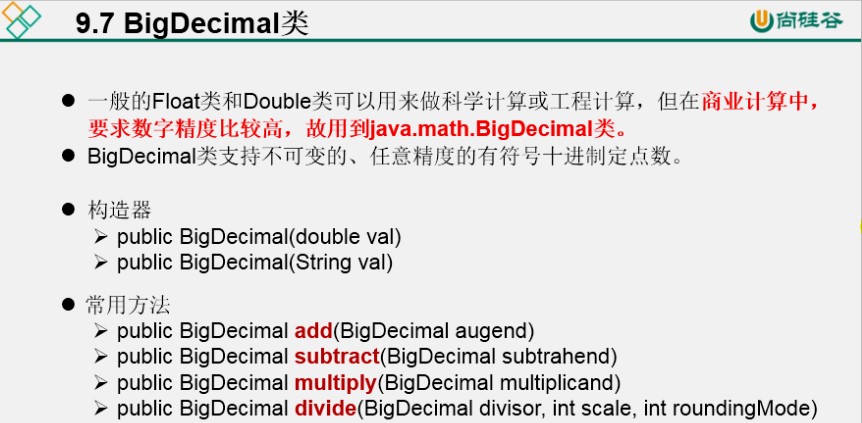
public void test2(){BigInteger bi = new BigInteger("12112112121211");BigDecimal bd = new BigDecimal("12234.56879");BigDecimal bd2 = new BigDecimal("11");System.out.println(bi);//System.out.println(bd.divide(bd2));System.out.println(bd.divide(bd2,BigDecimal.ROUND_HALF_UP));System.out.println(bd.divide(bd2,15,BigDecimal.ROUND_HALF_UP));}
